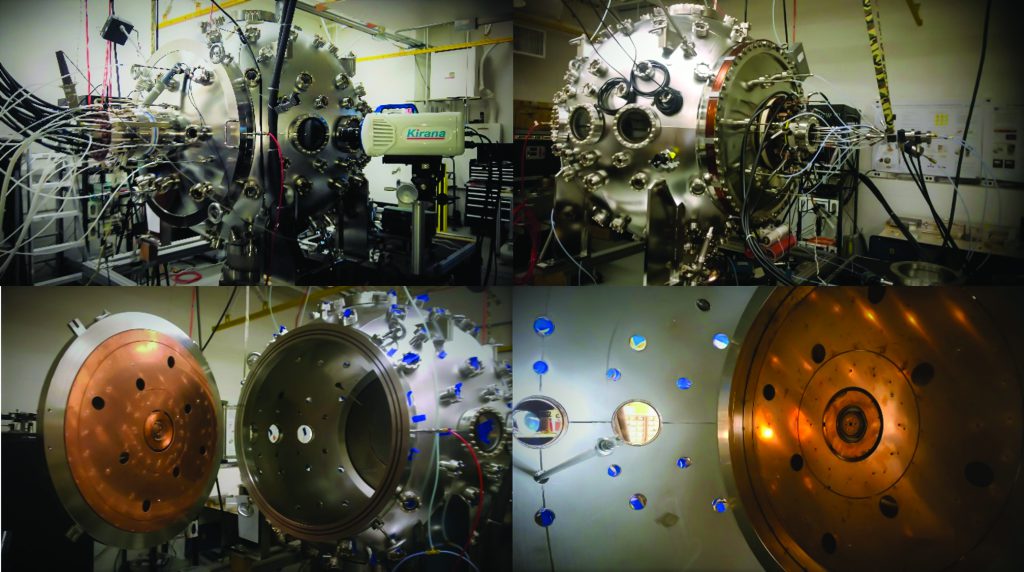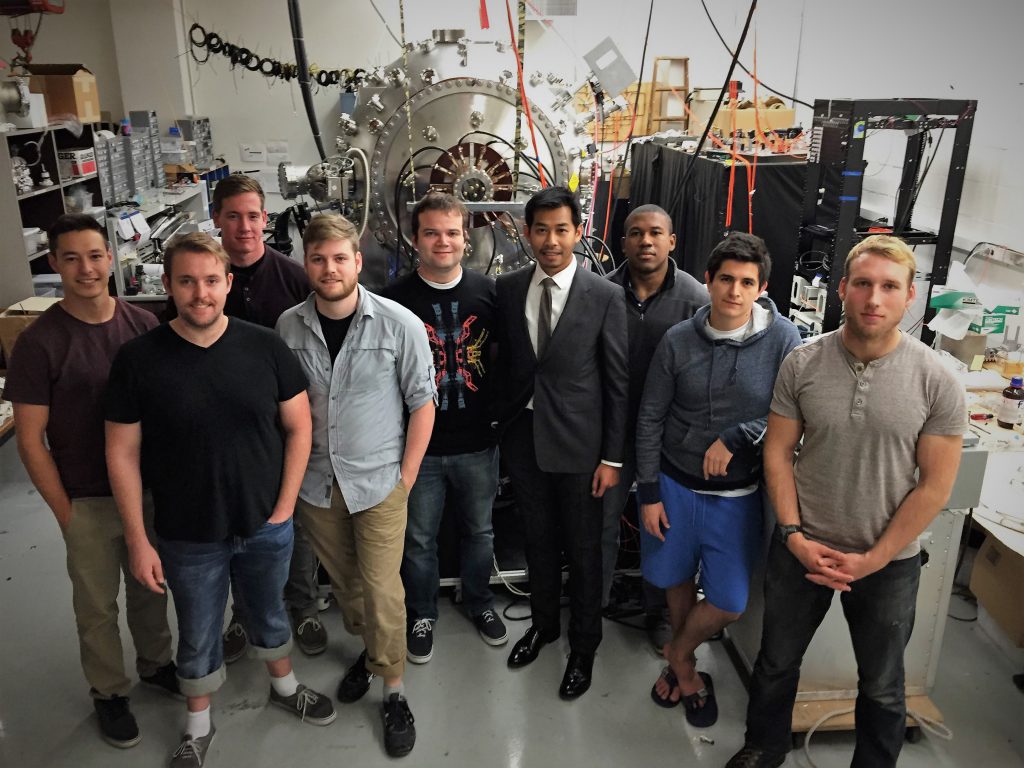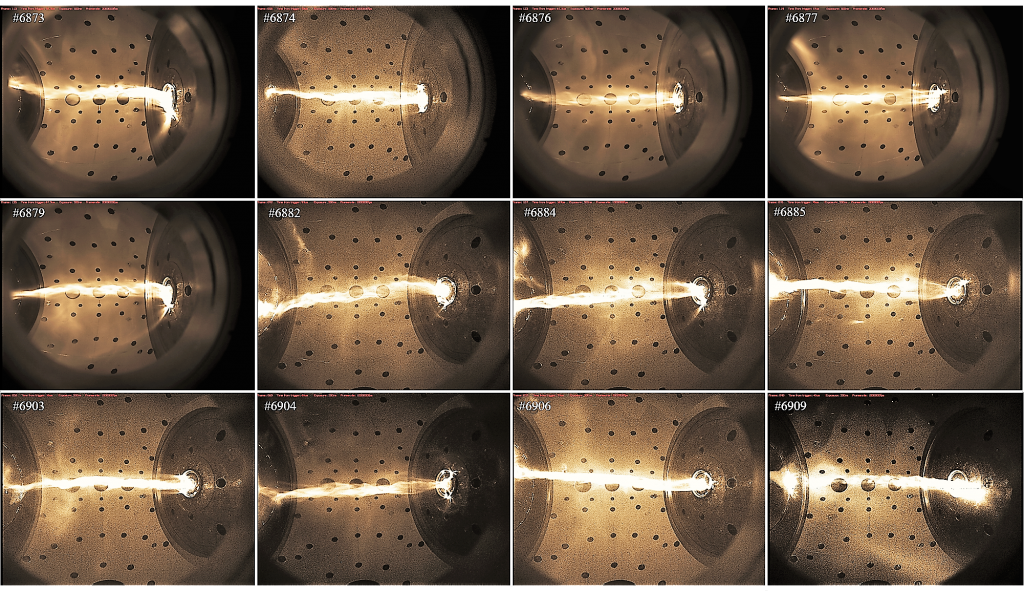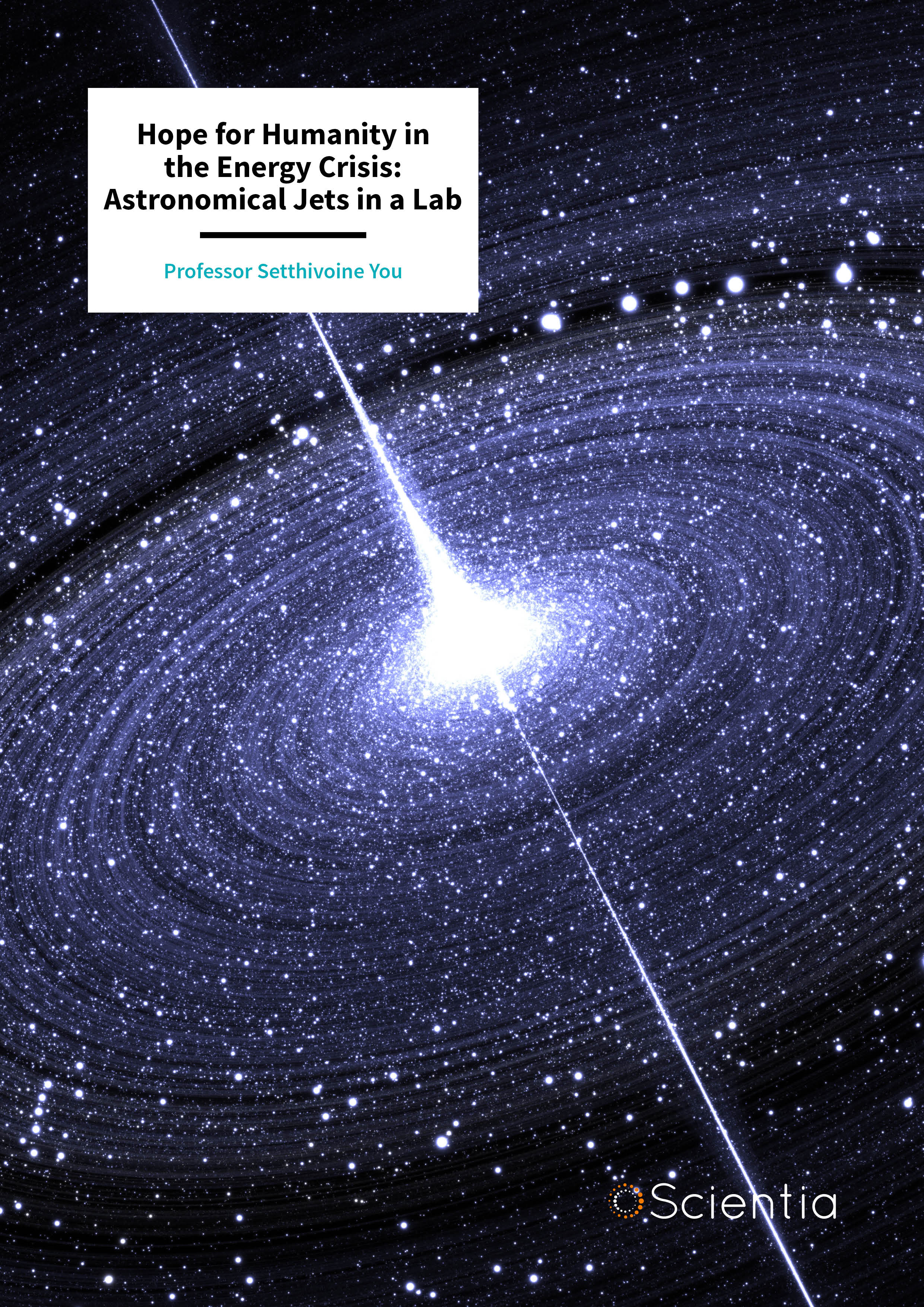Professor Setthivoine You – Hope for Humanity in the Energy Crisis: Astronomical Jets in a Lab
If we consider Earth as a closed box in which humanity has only ever lived, the second law of thermodynamics says that in the end, inevitably, the box will reach a state of maximum disorder. So, in the long run, there are two important ways in which our species might cope with the issue: switch to increasingly cleaner energy sources to push the deadline further away, and colonise the solar system to expand the size of the box. Professor Setthivoine You and his team at the University of Washington are currently working on making both outcomes possible.
The long road of civilisation has progressed with our ability to harness various forms of energy for power and transport. In the first age, fire was used for warmth and to light our way, while our feet carried us. Next, wind filled our sails, and we used animals to transport our goods and ourselves. In the third age, fossil fuels gave rise to an industrial revolution that has powered our modern civilization. Through the ages, the energy humans have harnessed has ultimately come from the Sun, which has been stored chemically and thermally – wood stores the energy of solar rays, animals feed on plants, wind blows due to uneven warming by the Sun, and fossil fuels that have stored the Sun’s energy from eons before.
The fourth age began with the scientific discovery of subatomic particles. One important implication of this was the development of nuclear energy. Within this nuclear age, we have left the Earth to explore our solar system, observed our planet from above, and built an internet that connects us and gives us unlimited access to information. All of these achievements, all those before and all those to come, rely on a continuous supply of energy and raw materials. Unfortunately, however, harnessing energy causes pollution and climate change, while digging for raw materials wrecks the ground. What if we could have a technology that could solve these problems? The ideal long-term solution would be to have a clean energy source that is not dependent on limited fuel supplies, and to then use this energy to colonise the solar system for raw materials instead of excavating our Earth. This technology has actually been pursued for decades – a technology that not only could eliminate the largest ecological crisis our species has ever encountered, but one that could spur a migration unlike any ever seen before. That technology is nuclear fusion, and it’s the same process that fuels the Sun.
Going Nuclear: Fusion vs Fission
Nuclear energy isn’t a new phenomenon – we’ve had nuclear fission working for decades – but the subtle differences between fusion and fission have a substantial impact on power output. Nuclear fission is the splitting of heavy atoms into two fragments, achieved by bombarding them with neutrons (a type of uncharged subatomic particle).
The process takes heavy elements like plutonium or uranium and splits them into lighter elements such as barium and lanthanum. During this reaction, a tremendous amount of energy is released – and it can be transformed into electrical power by heating water to produce steam to turn turbines. This is the same method used for practically all of our electricity generation, basically by replacing the coal or natural gas furnace with a fission reaction chamber. The advantage is that fission releases six million times more energy per kilogram of fuel than fossil fuel combustion. Therefore, instead of consuming 3 million tonnes of coal per year which releases 60 thousand tonnes of carbon dioxide (the key driver behind climate change) into the atmosphere, a typical power plant would only consume 250 tonnes of uranium, which releases no carbon dioxide, but produces 60 tonnes of dangerous radioactive waste.
Nuclear fusion, on the other hand, aims to do the opposite – it takes very light elements such as hydrogen and transforms them into heavier elements such as helium, by subjecting them to extremely high temperatures and pressures in an attempt to mimic the conditions at the centre of stars, such as the Sun. The advantage is that fusion produces four times more energy than fission per kilogram of fuel, so even less fuel would be needed. No direct radioactive waste or carbon dioxide is produced, only benign helium, and the reserves of hydrogen isotopes in the oceans are sufficient to last for hundreds of thousands of years.
However, contrary to fission or fossil fuels, the nuclear fusion process requires a vast amount of energy to get going. This can be likened to the process of lighting a match, where we need to put sufficient kinetic energy into the system by striking the match vigorously enough to heat the matchhead until it begins burning on its own. If we don’t strike it sufficiently, it only heats the matchhead. In fusion energy research, decades of scientific experiments have been striking this match with bigger and bigger machines. From small university-size experiments in the 1950s to the largest experiments in Europe, Japan and the US today, we have reached the point of breakeven (when the fusion energy output equals the heating energy input).

With the world’s largest fusion experiment – the pharaonic international ITER project – currently under construction, we are now moving towards the point of ignition (when the fusion energy output can sustain itself). But to be competitive, fusion energy must ultimately find a way to reduce the size and complexity of the reactors. Therefore, scientific research into the fundamental processes inside fusion systems, to understand the delicate interplay of turbulence, plasma flows, and magnetic fields, promises to make fusion energy reactors small enough to put on spacecraft. Professor Setthivoine You and his team at the University of Washington are one such team of scientists working towards obtaining this feat.
For the fusion process to work – that is, to get more energy out than you put in – three conditions must be fulfilled simultaneously: the fuel must be heated to more than one hundred million degrees, there must be sufficient fuel density, and the whole system must be confined together sufficiently long enough. Above 11,000°C, the fuel exists in the form of plasma – one of the fundamental states of matter (along with solid, liquid and gas). Plasma is effectively a gas that has been super-heated until its atoms begin to lose their electrons. The resulting matter contains negatively-charged free electrons and positively-charged ions. Plasmas are interesting because, unlike the other states of matter, the charged particles within plasma react strongly to magnetic fields. We can therefore use magnetic fields to keep hot plasma away from cold walls, and we can shape plasmas out the back of thrusters to propel spacecraft. But plasmas also exist naturally.
Here on Earth, plasmas exist naturally in lightning but are mostly created artificially – in plasma TVs, fluorescent lighting and ion thrusters designed for electric space propulsion. In space, however, you can find plasma occurring naturally in the magnetosphere, in the solar corona and the solar wind, in the cosmic interstellar medium, at the centre of stars, and in astrophysical jets. In fact, over 99% of matter in the visible universe is believed to be in the form of plasma.
Astrophysical jets are a particularly fascinating astronomical feature as they extend out for light years from the centre of accretion disks (disks of matter rotating around a central body, such as a star or black hole) in remarkably collimated beams. The exact mechanism that causes this is unknown, yet it is clear that strong plasma flows interacting with magnetic fields play a crucial role. Understanding how astrophysical jets are so long, so straight, and so stable can help us understand how to make fusion plasmas more stable, more compact and remain confined for longer. Astrophysical jets are natural nozzles, and understanding them can help scientists to improve plasma thrusters for electric space propulsion. This is just one aspect of a project that Professor You and his research team are working on.

The Mochi.Labjet Project
The Mochi.Labjet project is essentially a laboratory-based astrophysical jet created by Professor You and his team to study canonical flux tubes (tubes of magnetic plasma) and plasma self-organisation (the tendency of plasma to organise itself into complex arrangements on its own). As Professor You describes: ‘The Mochi project is a theoretical and experimental program designed to study the fundamental physics of plasma self-organisation. The goal is to understand and eventually harness this remarkable property of plasmas for compact magnetic fusion, understanding natural plasmas such as astrophysical jets and improving plasma space propulsion with magnetic nozzles.’ He goes on to say that, ‘the experiment replaces an accretion disk, that would rotate in a vacuum chamber at impractical speeds, with three independent concentric annular electrodes.’
The electrodes are used to mimic the rotation of an accretion disk around celestial objects, and this novel approach allows Professor You and his team to simulate and study astrophysical jets with reproducible and carefully-controlled experimental conditions. This up-close and personal manner of studying jets complements astronomical observations that are restricted to single viewpoints in space and time. The team’s aim is to verify predictions by the theory of canonical flux tubes that magnetic fields can be stabilised by helical flows, which can then be used in a variety of different applications, from nuclear energy to space travel. ‘With this theory of canonical flux tubes and the well-diagnosed experiment, the research program intends to improve the theoretical understanding of how astrophysical jets are highly collimated, often very straight and extremely long,’ says Professor You.
As mentioned above, plasmas can self-organise: they have a natural tendency to re-arrange themselves into various shapes on their own. Some of the shapes are like astrophysical jets launched from accretion disks, others are like donuts used in attempts to achieve fusion energy, while some are like arches that protrude from the surface of the Sun. The transition from one shape to another often involves flows, heating, and re-shaping of magnetic fields. These shape transitions can involve large instabilities, while at other times it stabilises them. Exploiting these spontaneous processes could help make magnetic donuts more stable and more compact by converting magnetic energy into flows, therefore helping to make fusion reactors smaller and cheaper. ‘Beyond laboratory astrophysics, the experiment can form plasma configurations to study the interaction between flows and magnetic fields,’ explains Professor You. ‘For example, in donut-shaped configurations suitable for fusion energy, flows can improve confinement and reduce the size of future reactors.’ As current technologies result in fusion reactors that are on the same scale as football stadiums, Professor You’s research has the potential to change the field of nuclear energy.

Aiming for the Stars
Along with playing a part in providing humanity with a potentially limitless energy source, Professor You’s research could also help usher in a new age of space exploration based on plasma engine technologies. Space travel involves converting energy stored in some form of fuel into kinetic energy to cover the vast distances in the cosmos. Nuclear fusion therefore has the potential to open up the solar system to human colonisation. But before this futuristic technology is achievable, plasma thrusters based on solar electric power already propel spacecraft around Earth and into deep space. They convert solar power into electrical power, which is then used to generate plasma. Then, using electric or magnetic fields, the plasma is ejected out of the rear of the spacecraft as an exhaust plume with much higher speeds than has ever been possible with chemical fuels. In space, higher exhaust speeds mean that you can use less fuel to go further and faster.
Plasma engines are the key to interplanetary travel, with NASA and private companies recently investing in plasma engines that promise to cut, for example, the journey time between Earth and Mars to just 39 days instead of 9 months. But going to Mars and beyond with heavy payloads such as human crews requires more energy than is available solely with solar power. Solar power coupled to plasma thrusters could be replaced by nuclear fission reactors coupled to the same plasma thrusters. But ultimately, fusion energy would be even more efficient, producing more thrust per kilogram of fuel directly from the plasma exhaust of fusion reactions. In this way, Professor You’s work on plasma jet collimation and stability has the potential to do just that.
In the meantime, when asked about the future direction of his research, Professor You keeps his feet firmly planted on the ground: ‘Another application is for space technologies such as plasma propulsion and space debris removal. A pair of plasma jets can control a target in space without any physical contact, so could de-spin and de-orbit debris to clean up the orbital environment. High power magnetised plasma jets could enable rapid interplanetary travel and the Mochi configuration has the advantage of a well collimated, high power plasma plume.’
There’s a short phrase used in science to describe promising research with multiple applications – the sky is the limit. But if the intellectual investment of Professor You and his research team pays off, the sky won’t be their limit – it will be their domain.
Meet the researcher

Professor Setthivoine You
William E. Boeing Department of Aeronautics & Astronautics
University of Washington
Seattle, WA
USA
Setthivoine You completed his MSc in physics at Imperial College, London in 1997, before going on to complete a PhD in plasma physics at the same institution in 2002. His research interests include plasma physics, laboratory astrophysics, magnetic flow measurement, fusion energy and space plasma propulsion. During his career do date, which has spanned four posts in three different continents, he has contributed to 22 journal publications, 54 conference proceedings, given 28 conference talks and attended 37 national and international conferences. He acts as a reviewer for numerous international journals and publishers and has been awarded multiple distinctions for his scientific work.
CONTACT
E: syou@aa.washington.edu
E: setthivoine.you@edu.k.u-tokyo.ac.jp
T: (+1) 206 616 8628
W: https://www.aa.washington.edu/research/youlab
KEY COLLABORATORS
Dr Jens von der Linden, Lawrence Livermore National Laboratory, USA
Dr E. Sander Lavine, University of Washington, USA
Evan G. Carroll, Lawrence Livermore National Laboratory, USA
Alexander Card, Max-Planck Institut for Plasma Physics, Greifswald, Germany
Morgan Quinley, Woodruff Scientific, USA
Manuel Azuara-Rosales, University of Washington, USA
Dr Simon Woodruff, Woodruff Scientific, UK/USA
Professor Paul Bellan, California Institute of Technology, USA
Professor Yasushi Ono, University of Tokyo, Japan
Dr Stéphane Mazouffre, Centre National de la Recherche Scientifique, France
FUNDING
US DOE
US DOE-SBIR
DOE-GSRP
UW AA
REFERENCES
S You, J von der Linden, ES Lavine, EG Carroll, A Card, M Quinley, M Azuara-Rosales, The Mochi.LabJet experiment for measurements of canonical helicity injection in a laboratory astrophysical jet, 2017, arXiv:1711.07213, 2017, https://arxiv.org/abs/1711.07213.
ES Lavine, S You, The topology of canonical flux tubes in flared jet geometry, Astrophysical Journal, 2017, 835, 89. DOI:10.3847/1538-4357/835/1/89
S You, GS Yun, PM Bellan, Dynamic and stagnatic plasma flow leading to magnetic flux tube collimation, Physical Reviews Letters, 2005, 95, 045002. DOI: 10.1103/PhysRevLett.95.045002




